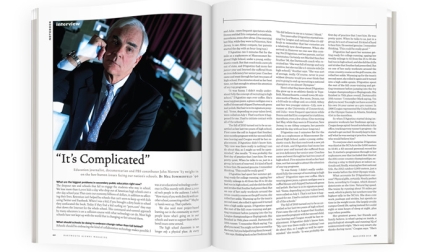Jodi Archambault Gillette stands on a small portico of the Old Executive Office Building, with a view overlooking the south lawn of the White House a stone’s throw away. She has just come from a meet-and-greet with 30 Native-American students next door, a gathering at which the attendance had shrunk as a result of a blizzard.
The glare of sunlight off the snow makes Gillette squint at her Blackberry as she and an assistant confirm that she would have to run right back to the West Wing for a budget meeting in less than an hour. Dressed in a lightweight blue blazer, her breath occasionally visible, she shrugs at the frost and arches her eyebrows above a high-wattage smile. “The city is almost shut down,” she says, “but this is nothing.”
It’s understandable that the biggest D.C. storm in 50 years would fail to impress a South Dakotan who went to college in New Hampshire. Although the weather might be “nothing,” Gillette’s occupancy of the office just across the hall from the balcony is truly something. In February 2009 Barack Obama named her a deputy associate director of the Office of Intergovernmental Affairs. A member of the Standing Rock Sioux, Gillette is the first Native American to hold the position, which serves as the administration’s primary liaison to the country’s 564 federally recognized tribes. Or, as Gillette puts it: “We’re their front door to the White House.”
Cynics might be forgiven if they jump to the conclusion that the post is a sinecure, a sop to a minority alliance. But Jacqueline Johnson, executive director of the National Congress of American Indians, is quick to disavow this notion. “This is, hands down, the greatest access we’ve ever had to an administration, and Jodi is a major reason,” says Johnson. “She facilitates matters so that on any given question the right expertise is in the room and the right conversation takes place. That’s often the hardest thing to ensure when tribal leaders come to town, but she makes it happen—which is particularly impressive when you realize she had no previous Washington experience.”
Johnson draws a distinction between Gillette and other relatively prominent Native Americans in different parts of the administration: “Jodi can get you to the people who make policy, not just the administrators.” This was true when tribes were seeking tax-exempt bond financing under Obama’s Recovery Act last year and when they sought a significant voice in health reform through 2009 amendments to the Indian Health Care Improvement Act of 1976. “The person in that intergovernmental position historically combined Indian Country issues with outreach to other governmental entities like municipalities and counties,” Johnson says. “We’ve never had someone whose sole portfolio is Indian Country.”
Gillette conveys an unusual combination of serenity and intensity that is perhaps a result of the varied landscapes she has inhabited. “Being raised in one of the poorest counties in the nation actually had a positive impact on me,” she says. “I was raised on the Pine Ridge Indian Reservation in Kyle, South Dakota. My parents made sure we grew up knowing our culture, our relatives and our community. That stays with you.”
The third of seven children, Gillette attended Little Wound School, a tribally chartered grant institution on the reservation that’s funded by the Bureau of Indian Affairs. Her father was an administrator of the school. Her mother was an educator with Montessori School certification. But it wasn’t just her parents’ pedagogic streaks that molded Gillette’s worldview. “Although I was surrounded by this abject poverty, the environment on the reservation was, and continues to be, a rich, traditional and close community with a strong foundation of Lakota values,” she says. “To the outside, reservations may seem hopeless. For those of us who call them home, reservations are filled with beauty, strengths, wisdom, assets and resilience that are truly amazing.”
As she reminisces on her place in the tribal education system, Gillette’s effervescence flattens a bit. Her smile dims. “You can hit a wall in the tribal school system,” she explains. “You can stop being challenged, and there are also big infrastructure deficits.” Has that been changing? “Not as quickly as any of us would like.”
Recognized for her potential, Gillette was tapped by the magic wand of the gifted-student fairy early in high school. She got a ticket to the power corridor with admission to a special prep school program. So she had received a little exposure to button-down shirts and docksiders before parachuting into Hanover.
“My culture shock happened when I attended a program called Mathematics and Science for Minority Students at the age of 15 at the Phillips Academy in Andover, Massachusetts,” she recalls. “I was enrolled in a program with a handful of East Coast urban minority youth who attended public schools with no preparatory opportunities for college. At that time I was taken aback by the wealth and privilege at Phillips Academy. By the time I arrived at Dartmouth in 1987 I was prepped and did not experience culture shock. I was comfortable there.”
Really? Minority and female students from just 10 years earlier have memories of at least occasional discomfort, to say the least.
“Look,” she says, “I grew there and had great friends. Academically I had really positive experiences in literature and government courses. I’ve erased the bad memories. Besides, I picked Dartmouth because of its reputation for recruiting and retaining Native-American students. It was an obvious path.”
She more than excelled. Majoring in government modified with Native-American studies, she was elected president of Native Americans at Dartmouth. She dined frequently with the board of trustees. She was a member of Casque & Gauntlet, a Tucker fellow, a Rockefeller Center intern.
So she was bright. She transcended some tough environs. And she made it through the Upper Valley winters. Did she then sharpen her elbows, descend on the nation’s capital and angle her way to the top of the Beltway political heap? Not exactly.
“Immediately after college I worked briefly for the Discovery Channel and KUSA in Denver on the documentary series How the West Was Lost,” she says. “Then I was the primary coordinator for the Our Visions: The Next 500 Years conference held in Taos, New Mexico, in 1992.”
So on to Hollywood or New York? Not exactly.
Gillette returned to the reservation, where she worked for her tribe as a grants writer and an economic development planner. Then it was on to a master’s from the Hubert H. Humphrey Institute of Public Affairs at the University of Minnesota, after which she began more than a decade leading the Native American Training Institute, a nonprofit social services organization based in Bismarck, North Dakota, designed to provide everything from foster parent instruction to navigation of the juvenile justice system.
Only in 2008 did Gillette’s path start turning toward politics, when she became North Dakota director of Native Americans for Obama. Even after the campaign withdrew its staff from the state, Gillette continued get-out-the-vote efforts without pay. “I was doing it because I was tired of everybody accepting the way things were,” she says. “And that’s why I was considered for the [White House] position. I wasn’t doing it just for myself or to end up with a job.” (Obama lost the state but carried the tribal counties, which had record turnout.)
How much does her background matter to what she does now and how she executes? “The president has assembled a diverse team,” Gillette says. “Being raised on the reservation has given me a unique perspective that allows dialogue with tribal leaders to begin with solutions, even as we discuss the historical background of the challenges confronting Indian Country. Many Native- American political appointees also bring experience with tribal governments to their positions, which helps ensure that Indian Country’s concerns are understood by the administration.”
Anyone who has ever spent time with members of more than one Native tribe will tell you the needs and cultures differ widely. The largely agricultural Hopi of the Southwest, for example, are deemed a “sedentary tribe,” compared to the neighboring—and historically more nomadic—Navajo, with whom they have had historical clashes. What are the challenges for one Lakota representing 564 different tribes to the White House? “Being raised on the reservation does not make me an expert on all issues affecting Native Americans,” says Gillette. “I realize every time I have a meeting with a tribe that it is important to recognize the similarities among tribes as well as their differences. I have learned a tremendous amount about the diversity of tribal nations and I have gained an appreciation of the uniqueness of each, from the Arctic to the Everglades.
“There are no hard and fast rules to use when working with tribes. There are tribes with large and small populations. Some are rich in resources; others have none. Some are located in rural America and in urban areas.”
One of Gillette’s meetings entailed a June 2009 trip to the wilds of Alaska, where a new federally funded tribal hospital was under construction. Each of the Native communities was accessible only by air—more remote than South Dakota. Although the situation was similar to those of many other communities, Gillette lamented the dearth of basic social and educational services there.
The precarious situation in Alaska, she adds, is made more acute by the ongoing recession. “Native-American people suffer from some of the highest unemployment rates, which are further exacerbated by the greater economic downturn,” she says. “Several tribes across the country hosted job forums in December. We met recently with tribal leaders and business leaders to hear their ideas about how to create jobs in Indian Country.”
Jobs—as in shovel-ready and backed by $3 billion in Recovery Act money to address needs in Native-American communities. “It has created jobs in housing, construction, hospitals and schools,” says Gillette, “and is funding projects that improve Indian healthcare and nutrition, make communities safer and provide suitable housing for tribal communities. In addition, the Recovery Act has addressed some of the infrastructure challenges in Indian Country, like water and roads, and has helped to lay the foundation for sustainable tribal economies.”
Among her many other attributes Gillette is an award-winning tribal dance competitor and an avid basketball player. “That’s how I met my husband,” she says, “dancing at powwows and playing basketball.” A graphic artist with his own business, Russell and their three children—6, 11 and 16—live with Jodi in Falls Church, Virginia.
Are there any hours in the day for basketball? “Not really,” she says. “Though I play in the White House gym.” Any hoops with the president? A slight tilt of her head accompanies a vaguely wistful look: “He doesn’t have time to play quite as much as he used to.”
The president convened the much-ballyhooed White House Tribal Nations Conference toward the end of 2009. It was there that Obama drew loud applause when he introduced Gillette to the audience by saying, “I promised you a voice on my senior staff in the White House so that you’d have a seat at the table when important decisions are being made about your lives, your nations and your people. And that’s why I appointed Jodi Gillette of the Standing Rock Sioux Tribe to work directly with all of you.”
Gillette stresses that the conference led to direct, not just symbolic action. “The president directed all relevant federal agencies to submit plans and regular progress reports on how they will consult with Indian tribes in compliance with an executive order,” she says. “Additionally we have made significant progress on multi- agency collaborative approaches to addressing priorities identified at the conference and through listening sessions. For example, the departments of Justice and Interior are collaborating to address law enforcement issues, and Education Secretary Arne Duncan and Interior Secretary Ken Salazar are participating in joint efforts on Indian education.”
The top three items on the Indian Country agenda? Gillette is unequivocal: “Jobs, healthcare, education.”
But two other pledges to Indian Country that Gillette says Obama has fulfilled include the titular and the litigious. She ticks off a string of administration appointments of other Native Americans, culminating with Kimberly Teehee, who directly advises the president on Native-American policy, and Interior’s lead attorney, Hilary Tompkins ’90 (like Gillette the first Native Americans to fill the positions). Additionally, she says, the administration has settled one of the largest ($3.4 billion) and longest (extending through the 1990s to the Clinton administration) class action suits against the federal government in history. Without getting into the weeds, the litigation involved long-standing claims that Interior had mismanaged huge sums within an Indian trust account, claims that had bedeviled ministers of both parties. Although Congress must still implement the deal (never a foregone conclusion these days), the settlement represented excision of a cancerous tumor that had sickened Native-federal relations.
“Ultimately it’s a two-way street,” says Gillette. “I connect tribal leaders with White House officials who might serve on the Domestic Policy Council or the Office of Management and Budget or the Council on Economic Quality. And members of the administration hear from tribal representatives who can explain the state of a particular reservation or have an insight into climate change or maybe ocean policy.”
On the Old Executive Office Building portico the sun moves over the yardarm and Gillette glances at her Blackberry. The West Wing was beckoning. A Native American of pioneering rank in a presidential administration—one still deeply connected to Indian Country and its challenges—was needed at the White House.
Dirk Olin is editor-in-chief of Corporate Responsibility magazine. He lives in Maplewood, New Jersey.




